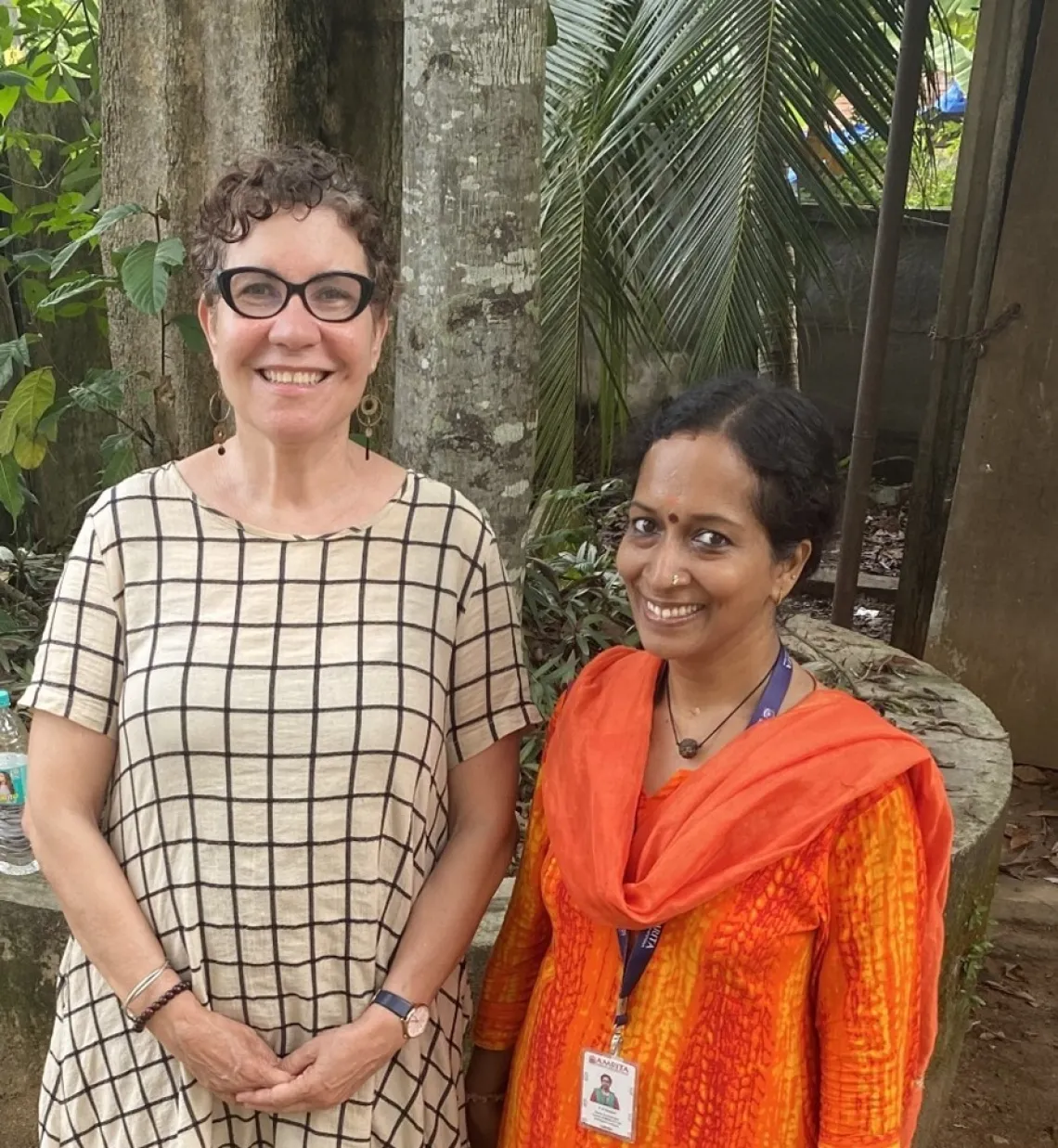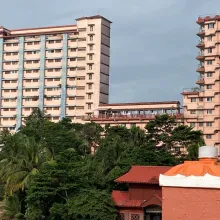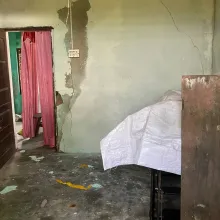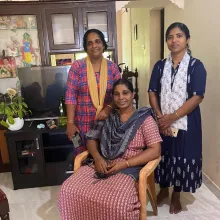The Collective Economics of Self-Help Groups: A View from India

Caption from author: A picture of myself (at left) with Shalini who was my guide and translator for the entire duration of the project. Shalini works at the AMMACHI Lab and the Center for Women Empowerment and Gender Equity and was an amazing resource. With her support, I was able to conduct a needs assessment with the women of Blossoms Self-Help Group, which enabled me to develop my research and project deliverables.
Human Rights Practice MA student Sharon Danjuma recently participated in the Live-in-Labs program run by UA educational partner institution Amrita University in India. Sharon's experience at Amrita was supported in part by the Resilience Internships and Student Experiences (RISE) Program sponsored by the Arizona Institute for Resilience.
by Sharon Danjuma

Caption from Author: During my stay, I ate my breakfast at the Amritapuri Ashram, in the village. The Ashram is the birthplace, and the worldwide headquarters of Amma’s worldwide NGO. Amma-also known as the Hugging Saint-is the founder and Chancellor of Amrita Vishwa Vidyapeetham University. I met many of Amma’s devotees from all over the world. I also had the opportunity to participate in a Darshan and the privilege to meet and receive a hug and a gift from Amma herself.
At the height of COVID, India’s economically disadvantaged women found themselves unemployed and pushed further into poverty. In response, India’s Ministry of Skill Development and Entrepreneurship, with funding from the World Bank, created the Skill Development and Entrepreneurship Skill Acquisition and Knowledge Awareness for Livelihood Promotion (SANKALP) program to train up economically marginalized women and transgender individuals. One of the sites chosen for the execution of the program was Amrita University's Center for Women Empowerment and Gender Equality. The Center designed and implemented a comprehensive intervention approach built around skills training and formation of Self-Help Groups (SHG), which became the backbone of Amrita’s delivery of the SANKALP’s initiative.
As a University of Arizona Human Rights practice student, with funding from the RISE program, I had the opportunity to spend three weeks in Kerala, Indian working with Amrita University and the Center. My initial project was to assist the women of the Blossoms Center, a stitching and tailoring- Self-Help Group-scale up for sustainability.

Caption from author: The interior of the Blossoms Self-Help Group center, which along with all the sewing machines, was damaged during a recent monsoon a few months prior to my arrival. When I met with the women of Blossoms, they talked about wanting to return to the center to work as a collective but lack the resources to make the needed repairs. Without a worksite, the women are currently working individuality from their homes and are only able to take small orders.
Self-Help Groups, also known as collective economics, is an economic development tool that aims to break the traditional barriers to women’s empowerment. The formal structure, first emerged in the 1970s as a research pilot project, by Dr. Muhammad Yunus in Jobra, a village in the Chattogram district of Bangladesh. The project would later become Grameen Bank which provides opportunities for economic independence and financial sustainability through microfinance, also known as “solidarity group lending.”
However, this collective form of economics dates back even further. Growing up on the Caribbean Island of Trinidad and Tobago, my mother and my aunts were all a part of this monetary structure, known in Trinidad as a Sousou. This centuries old practice, which originated in West Africa, assisted the women in my family in times of financial strife. Through the savings of the Sousou, parents could buy school supplies and Christmas gifts.
Today, SHGs are self-governed, peer-controlled associations of approximately 15-25 members, predominately women, of similar economic and social backgrounds, coming together to improve their living conditions. The members organize around a particular economic activity and pool their financial resources. The collective must be functioning for at least six months before they are able to obtain a microcredit loan to scale the business. The lending typically comes from a financing source such as an NGO or Grameen Bank. It’s the model used by the United Nations Development Program for promoting women’s self-reliance in war torn regions in Syria.
In addition to economic empowerment, women that are part of SHGs tend to show improved social empowerment. The research suggests that the strong solidarity and the social networks to be a key driving force towards social change. However, the SHG model is not without problems. For example, poor leadership, lack of financial and saving knowledge, and illiteracy complicates the operations and functionality. Addressing these challenges through support, and capacity building from institutions could mean the difference between success and failure.

Caption from author: Three of the four women who were part of the Blossoms Self-Help Group. During this meeting, which took place in one of the member’s homes, I conducted a needs assessment and had an opportunity to see some of the apparel. Despite not having access to a work center and using machines that needed repairs, the women were very resilient and resourceful.
Immediately, after my first meeting with the women from Blossoms, it was evident they were not a functioning SHG. The group, which originally comprised of ten members, now consisted of four. The work center and the sewing machines were damaged by a recent monsoon. Despite, these setbacks, the women were very resilient. After retrieving whatever they could from the center, including a workable sewing machine, they worked from their homes, and assisted each other with the construction of apparel, including what they called frocks. They all voiced wanting to return to the center to work as a collective, but they did not have the resources for the needed repairs. Despite the devastation and loss, the women did not see themselves as “victims” but as a collective in need of support.
Though SHGs have a record of success, and have shown positive effects on women’s financial independence, it does deviate from capitalism economic system and “disaster capital” is not available for recovery efforts. Members are vulnerable to exploitation and devastation, and they do require extensive support, particularly in the early formation stages. Research suggests that when SHGs are regularly monitored within the first five years of formation they have higher long-term success rates. After seeing the center’s condition, listening to the women call for assistance and their frustration, my project shifted from scaling for sustainability to suggesting that the host organization provide regularly scheduled trainings, monitoring, and support to assist in the recovery effort. However, I did not know that the work I started in India would create an impact in United States.
I am the Grants Manager/Compliance Officer at a public organization in New Orleans, where I work with developers and contractors who are recipients of Federal dollars for community and economic development projects. A part of the funding necessitates grantees abide by Federal regulations, which require hiring low and very low-income employees. However, I often hear the frustrations with the challenges of finding dependable, qualified workers.
When my project with the women at Blossoms shifted from scaling for sustainability to training and monitoring, I shifted to developing a six-week training curriculum and lesson plans. The training manual consists of workshops on financial literacy and money management, problem solving, business skills and marketing, communication, digital literacy, and decision making. Due to time constraints, I was not able to complete the instruction booklet while in India. On my return to the US, I continue to develop the material as a resource to assist contractors and developers fulfilled their regulatory requirements on the federally funded projects, including a Land Trust developer, which is a collective economics form of affordable housing.
Today, much of my work is the continued rebuilding of New Orleans, 24 years after Katrina, and the skills I gained in India is transferrable to my job. The project, Amrita University, the University of Arizona with the funding from the RISE program offered me a tremendous opportunity to engage in meaningful and practical professional work that’s adding value, creating resources and opportunities. I knew I wanted to make a difference with the women at Blossoms, I did not know that my work in India would have an impact in New Orleans creating and adding value for the city’s economically marginalized workers.
In summary, the Collective Economic system provides opportunities and alternatives to capitalism for individuals to gain financial stability and build wealth. However, the members are often one crisis away from devastation, as was the situation with the Blossoms Center. When it came time to leave, I felt an incredible sadness. I wanted to see the group functioning and financially stable, but I had to come to terms with the reality of the current situation. As I flew back home, I kept reflecting on the experience. By Western standards, the women appear to have few material possessions. However, they had substantial assets. They were incredibly resilient, industrious, kind and welcoming and taught me that challenges are opportunities for growth, change and adaptability.

